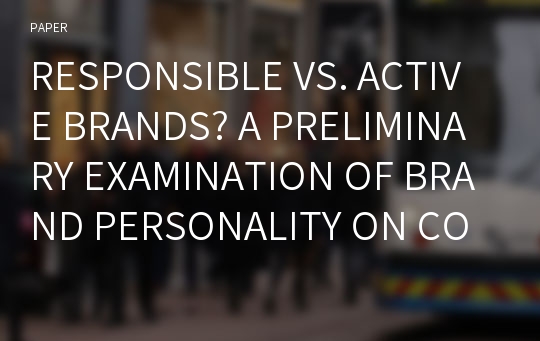RESPONSIBLE VS. ACTIVE BRANDS? A PRELIMINARY EXAMINATION OF BRAND PERSONALITY ON CONSUMER-BRAND RELATIONSHIPS
* 본 문서는 배포용으로 복사 및 편집이 불가합니다.
서지정보
ㆍ발행기관 : 글로벌지식마케팅경영학회(GFMC)
ㆍ수록지정보 : Global Marketing Conference
ㆍ저자명 : Sebastian Molinillo, Arnold Japutra
ㆍ저자명 : Sebastian Molinillo, Arnold Japutra
영어 초록
Increasingly, there is a rise of interests from practitioners and academics on the topic of consumer-brand relationships (CBR). It has been argued that consumer build relationship with a brand in consonance with its personalities. Thus, this study investigates the role of brand personality in predicting prominent CBR constructs, such as brand awareness, brand trust, and brand loyalty.Researchers consider brand personality as one of the prominent constructs in predicting consumer preferences and choices (e.g. Eisend & Stokburger-Sauer, 2013; Gordon, Zainuddin, & Magee, 2016; Guèvremont & Grohmann, 2013). It has been established that brands are capable to have personalities (Aaker, 1997; Geuens, Weijters, & De Wulf, 2009). The study of brand personality flourished since Aaker (1997) created a brand personality scale (BPS). According to her, brand personality reflects five main dimensions: sincerity, excitement, competence, sophistication, and ruggedness.
Out of these dimensions, many studies mainly focus on two dimensions, sincerity and excitement respectively (e.g. Aaker, Benet-Martinez, & Garolera, 2001; Hosany, Ekinci, & Uysal, 2006; Ivens & Valta, 2012; Sung, Choi, Ahn, & Song, 2015). These studies consider these two dimensions to be of important since these dimensions appear to capture much of the variance in personality ratings of brands (Aaker, 1997) and are considered prominent to the marketing landscape (Aaker, Fournier, & Brasel, 2004; Guèvremont & Grohmann, 2013; Toldos-Romero & Orozco-Gómez, 2015).
Although Aaker's BPS represents the most prominent operationalization of brand personality (Eisend & Stokburger-Sauer, 2013; Matzler, Strobl, Stokburger-Sauer, Bobovnicky, & Bauer, 2016; Freling, Crosno, & Henard, 2011), her model has been the subject of several critiques. Researchers argue that the scale measures brand identity rather than brand personality (Azoulay & Kapferer, 2003), the scale is too general and simplistic (Austin, Siguaw, & Mattila, 2003), the scale does not include negative factors (Bosnjak, Bochmann, & Hufschmidt, 2007), and the scale is non-generalizable and non-replicable cross culturally (Arora & Stoner, 2009; Geuens et al., 2009). These shortcomings led researchers to construct an alternative to Aaker’s BPS. Geuens et al. (2009) develop a new measure of brand personality, which includes five dimensions: responsibility, activity, aggressiveness, simplicity, and emotionality.
Although many studies scrutinize on Aaker’s brand personality scale, only limited studies apply Geuens et al.’s BPS (e.g. Garsvaite & Caruana, 2014; Goldsmith & Goldsmith, 2012; Gordon et al., 2016; Matzler et al., 2016). Thus, the present study investigates the relationships between brand personality, using Geuens et al.’s (2009) scale, and three important consumer-brand relationships (CBR) constructs. These three constructs are brand awareness, brand trust, and brand loyalty.
Aaker (1991) conceptualize brand equity to include five important constructs, which includes brand awareness and brand loyalty. Meanwhile, Keller (1993) notes that brand knowledge is an important component of brand equity, consists of brand awareness and brand image. In addition, brand trust has been considered to be essential in influencing brand performance (Chaudhuri & Holbrook, 2001). Hence, the focus of the present study lies on these three variables.
As it has been discussed above, researchers consider sincerity and excitement to be essential in investigating consumer behavior. In light of a shortage of studies in applying Geuens et al.’s (2009) BPS, the present study examines two personality dimensions, which are conceptually similar to Aaker’s (1997) BPS: responsibility to replace sincerity and activity to replace excitement (see Table 1). To the best of our knowledge, no research has investigated the relationships between these three consumer-brand relationships constructs (i.e. brand awareness, brand trust and brand loyalty) and the two most relevant brand personality dimensions (i.e. responsibility and activity). The present study contributes to the marketing literature in three different ways. First, this study adds to the body of knowledge on the relationship between brand personality and CBR constructs using the new measure of BPS. Second, this study assesses the individual level of the new BPS, particularly responsibility and activity, on the three CBR constructs. In doing so, this study responds Keller and Lehmann’s (2006) and Geuens et al.’s (2009) call to assess the individual capacity of the brand personality dimensions to get consumer preference or loyalty. Third, this study displays which out of the two dimensions of the new BPS (i.e. responsible and active) are more important to predict the three CBR constructs. In this research, data were collected from Spanish respondents using online survey with snowballing technique. In total, 347 respondents participated in the survey. After checking for incomplete questionnaires and missing values, 8 questionnaires were dropped. Hence, 339 questionnaires were used for the analysis. Before conducting multivariate analysis, normality tests were conducted. The measurement and structural models was tested using AMOS 18, employing the Maximum Likelihood (ML) method. We find that brand personality predicts these three CBR constructs. Brand personality explains 56%, 58%, and 45% of the variance in brand awareness, brand trust, and brand loyalty, respectively. The results show that the strongest link is between brand personality and brand trust.
Su and Tong (2015) find that there is no relationship between exciting personality and brand awareness. On the contrary, this study displays that being an active brand leads to higher brand awareness. Even the results show that active brands are more likely to build brand awareness compared to responsible brands. However, in order to build brand trust and brand loyalty, responsible brands are more preferred compared to active brands. These results are in line with Eisend and Stokburger-Sauer (2013) that reveal weak relationships between excitement on brand attitude and brand commitment. These days, consumers prefer the brands to be more responsible or sincere. As Kotler (2011) argues that there is a shift in marketing that consumers pay more attention toward social responsibilities.
Interestingly, the results show that being too active could negatively affect brand trust and brand loyalty. Although the association is not statistically significant, Banerjee (2016) finds that excitement brand personality has a negative association with brand preference. A study also finds that excitement does not predict employer brand trust (Rampl & Kenning, 2014). One explanation could be that the brands would like to be something that is an opposite of what they are claiming. Guèvremont and Grohmann (2013) argue that when a sincere brand attempts to flatter the consumers, it decreases brand attitude and increases disappointment. However, this does not occur when flattery comes from exciting brands.
Brand managers should be very careful in communicating their brands personalities. Communicating to the consumers that their brands are responsible as well as active is good. However, brand managers should understand the interplay between these two opposing personalities. Consumers may believe that the brand is a responsible brand but also a little bit active. However, communicating two different opposing personalities at the same time may confuse the consumers. This is due to consumers’ disconfirmation of expectations (Guèvremont & Grohmann, 2013).
Although this study enlightens the literature of brand management, it is not without its limitations. This study collects data from a cross-sectional study in Spain. In order to generalize the results of this study, future studies should replicate the conceptual framework cross culturally. Particularly on the negative effects of active personality toward the three CBR constructs.
Furthermore, Spanish has been regarded as individuals with high uncertainty avoidance (Hofstede, 2001). Uncertainty avoidance increases the reliability of the brand personality dimensions, namely sincerity and excitement (Eisend & Stokburger-Sauer, 2013). Thus, it would be interesting to know whether differences occur between high and low uncertainty avoidance respondents. In addition, future studies should also account for other individual differences, such as attachment style. Japutra, Ekinci, Simkin, and Nguyen (2014) note that attachment style plays a prominent role in predicting consumer behaviors.
참고 자료
없음"Global Marketing Conference"의 다른 논문
 THE ROLES OF GREEN PACKAGING IN UGLY FOOD PURCHASE INTE..22페이지
THE ROLES OF GREEN PACKAGING IN UGLY FOOD PURCHASE INTE..22페이지 THE IMPACT OF INDUCED AWE ON ETHICAL TOURIST BEHAVIORS5페이지
THE IMPACT OF INDUCED AWE ON ETHICAL TOURIST BEHAVIORS5페이지 A BIBLIOMETRIC ANALYSIS OF SPIRITUAL TOURISM RESEARCH15페이지
A BIBLIOMETRIC ANALYSIS OF SPIRITUAL TOURISM RESEARCH15페이지 SOCIAL NETWORK ANALYSIS AND RESPONSE TIME TESTING: CONS..11페이지
SOCIAL NETWORK ANALYSIS AND RESPONSE TIME TESTING: CONS..11페이지 THE EFFECTS OF PARA-SOCIAL INTERACTION ON ONLINE CELEBR..3페이지
THE EFFECTS OF PARA-SOCIAL INTERACTION ON ONLINE CELEBR..3페이지 THE INFLUENCE OF OPINION LEADERS ON DAILY DEALS USER’S ..3페이지
THE INFLUENCE OF OPINION LEADERS ON DAILY DEALS USER’S ..3페이지 HOW IMMERSIVE RETAILING AFFECTS CONSUMERS’ URGE TO BUY:..6페이지
HOW IMMERSIVE RETAILING AFFECTS CONSUMERS’ URGE TO BUY:..6페이지 KEY TO SUPERSTARDOM IN A GLOBALISED MARKET: THE ROLE OF..6페이지
KEY TO SUPERSTARDOM IN A GLOBALISED MARKET: THE ROLE OF..6페이지 A POST-PANDEMIC LOOK AT TOURISTS’ PERCEIVED COOLNESS OF..4페이지
A POST-PANDEMIC LOOK AT TOURISTS’ PERCEIVED COOLNESS OF..4페이지 EXTRACTING OFFLINE RETAIL SHOPPING PATTERNS: OLLABORATI..5페이지
EXTRACTING OFFLINE RETAIL SHOPPING PATTERNS: OLLABORATI..5페이지




















